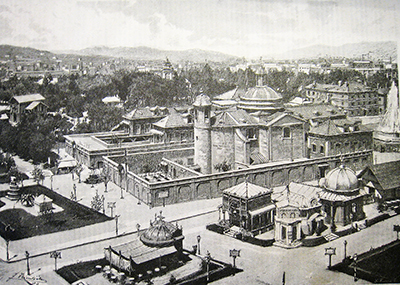Antoni Gaudí is one of those figures of the art world whose work cannot be confined to any one medium. He was an architect, one who helped to revolutionise surroundings as a major exponent of the Catalan Modernist movement, a large-scale attempt to help boost the reputation of the Catalan region as a major presence in European art and literature.
But Gaudi has also left his mark on two-dimensional media: depictions of his buildings are widely prized as artistic prints. A drawing or photograph of an Antoni Gaudi building will make for a handsome addition to any household wall. One of Gaudi's most iconic creations was the Pabellón de la Compañía Trasatlántica, which he built for the Universal Exhibition of Barcelona in 1888. This lavish building reflected Gaudi's interest in orientalism, when he was influenced by the artwork and architecture of India, Japan and the Islamic world. It was located near the sea, as part of the exhibition's maritime section.
The 1888 exhibition is generally considered to be the birthplace of the Catalan Modernist movement, which lasted until the death of the influential poet Joan Maragall in 1911; because of this, the Pabellón de la Compañía Trasatlántica could be said to encapsulate the very beginnings of the movement: a mission statement or manifesto in the form of a building, each element of its structure pointing towards a possible future for architecture.
Although the Pabellón de la Compañía Trasatlántica was demolished following the end of the exhibition, depictions of it still retain their appeal. There is a certain irony in the fact that this building, a pinnacle of modernism during the late nineteenth century, is now a long-gone object from the past; but that irony serves only to increase the allure of the structure. Simply by looking at an image of the building, a viewer can be transported into a bygone time, one full of a taste for the exotic and a hope for the future. Nobody with an eye for art can resit the pull of an image such as this: every detail captures an element of an age that now exists only in memory, but which can be rekindled with our imaginations.
If you are looking for a new artistic print to display in your home, then why not think about choosing the Pabellon de la Compania Trasatlantica by Antoni Gaudi? It will certainly make for an interesting conversation piece: visitors will doubtless ask about the building depicted in the image, and you will be able to fill them in on the fascinating history relating to the structure -- a history that touches upon turn-of-the-century architectural trends, the dawn of a new artistic movement, the influence of art styles between cultures, and the fact that even a building that no longer exists can have an afterlife in two-dimensional artistic media.




